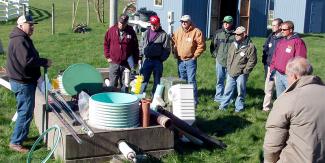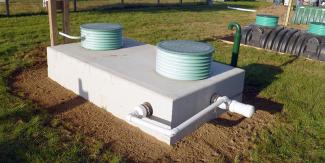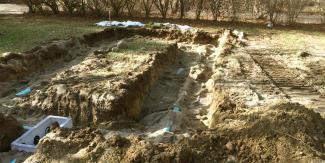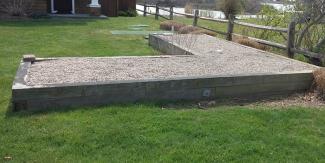Septic & Onsite Wastewater Treatment Systems
The DEM Onsite Wastewater Treatment System (OWTS) Program administers the States’ septic system permitting program to ensure the protection of public health and the natural environment while focusing on customer service. DEM staff provide regulatory oversight in three main stages of the septic system permitting process:
- Site-suitability: A preliminary stage which assesses the suitability of a parcel of land for on-site sewage treatment
- Treatment system design review: To determine a design's compliance with State standards, rules and regulations
- System installation: Field inspections are conducted by DEM staff during the key stages of system siting and installation.
OWTS (Septic System) Records
Looking for OWTS (Septic) Records? Search Online First!
- DEM has records of most Onsite Wastewater Treatment (Septic) Systems, or “OWTS” from 1968 through today.
- Historic Permit Search: View historic information, permit status, and download documents prior to April 17, 2025.
- Active Permit Search: View application status history, application materials, and final permit documents.
- If the information available online is not sufficient to meet your needs, please submit a Records Request Form to DEM.FileReview@dem.ri.gov. Requests for electronic copies will be satisfied within ten (10) business days. Requests to review records in-person at DEM will be satisfied within two (2) business days.
- If you are still unsuccessful in your search, it is likely that DEM does not have a record of your system. Please contact an OWTS professional to assist you.
Questions? Contact OWTS Program staff at DEM.OWTS@dem.ri.gov or (401) 222-3961.
Frequently Asked Questions
DEM has records of most septic system permits from 1968 to present. Depending on when your house was built records may be available in an electronic format via the DEM website or a physical copy of the file may be available in the DEM archives.
DEM septic system records are filed by the Assessor’s Plat and Lot when the property was built. This information is available from the Assessor’s office in the town where the subject property is located. The local tax assessor will also be able to provide you with the original property owner’s name, and the year the property was first developed. In addition, records may not list the property by the current address so you may, in some cases, need to contact the Assessor’s office to determine the original Assessor’s Plat and Lot number. Lastly, if the subject property is located within a subdivision, you will also need to ask for the sub lot number.
If you cannot find a “Certificate of Conformance” for your septic system, the owners that installed the system likely did not apply for the proper permits through DEM. If this is the case no record of the system will be available. If you wish to locate your system and evaluate if it is functioning properly you will need to hire a private registered septic system inspector. If you are looking to sell your property and the existing non-conforming system is not failing, then it is not necessary to replace the system. If your system is failing it must be replaced as soon as possible. If it is a cesspool then the system must be replaced within one year of the date of the property transfer. See additional cesspool FAQs on this webpage for additional information.
An online record request should be submitted to the DEM if the information that is available on the website is not sufficient to meet your needs. For example, if you wish to view the entire permit application file which may include additional information such as system location, a description of the treatment system components, a site plan, number of bedrooms the system is designed to support, and the depth to water table then an online record request should be made.
Option 1: Submit an online request to view and copy records at the DEM Headquarters. Within 2 business days of your online request the file(s) will be retrieved from the DEM archives and will be made available for you to review or photocopy in person. Hardcopy records will be made available to you at the DEM Headquarters in Providence. If a record cannot be located as requested the DEM will notify you prior to your arrival. (Directions to DEM’s Providence Office)
Option 2: Submit an online request to have an electronic copy of your requested record generated and sent to you via email within 10 business days. DEM staff will then retrieve your record from the archives, scan the file contents, and email an electronic copy of the requested records directly to you.
If the application is for a New Building Construction (NBC) or an Alteration application, the review process is typically 3 weeks. If the application is for a Repair application, the review process is typically 1-2 weeks.
DEM recommends you contact a septic system inspector to help locate and identify your septic system. Please refer to the OWTS Professionals page for a list of septic system professionals.
First you will need to conduct an online search for your original septic system permit. If the number of bedrooms that you desire is greater than the number of bedrooms that your septic system was approved to address you must hire a DEM Class II or III OWTS Designer. The Designer will then apply for an Alteration or a New Building Construction permit with the DEM, depending on the number of bedrooms to be added.
If you are not increasing the number of bedrooms than the number that was approved in your DEM OWTS permit, you may still need to file a Residential System Suitability Determination application to the DEM. This application will allow the DEM to evaluate if your septic system is properly designed and sized to address the changes you are proposing. Contact your local building official to determine if such an application is necessary in order for you to move forward with your project
The definition of a “failed” septic system or cesspool can be found in OWTS Rule 6.8.A.30 under “Definitions”. See definition of “Failed OWTS” for a complete description. View the regulation at Rules Establishing Minimum Standards Relating to Location, Design, Construction and Maintenance of Onsite Wastewater Treatment Systems.
If you suspect that your system has failed the first step is to hire a private registered septic system inspector to conduct a thorough inspection of your system. The inspector will provide you with a written report summarizing the inspection findings and will include recommendations. If your system has failed you will need to hire a licensed OWTS Designer to prepare a repair plan for DEM review and approval.
Costs can vary on site conditions but typically run from $10,000 – $18,000 for a conventional type of system. If the type of system you require is an Innovative/Alternative Technology, the range could be from $23,000 to $32,000.
A few but not all municipalities participate in the Community Septic System Loan Program (CSSLP) which offers low interest loans if your current system is failing. View a summary of this and other available financial assistance programs below.
In general, most of the State requires a conventional type of technology, however, DEM has deemed certain areas to require a more advanced technology (DEM’s Critical Resource Area and others)
Start by searching for a record of your septic system on this webpage. Once you determine the application number associated with your system you can either view the records online or submit a records request by email. When you obtain copies of your records you will want to locate the “Certificate of Construction”. This document can be used to locate exactly where each component of your septic system is on your property in relation to the building foundation. If you need additional assistance locating your system it is recommended that you hire a private septic system inspector. View a list of OWTS Professionals.
Commonly asked setback measurements:
- Private well to leach field = 100 feet. Private well to septic tank = 75 feet.
- Leachfield to property line = 10 feet. Decks to septic tank or leach field = 5 feet.
- In-ground pool to leach field = 25 feet, Above ground pool to leach field = 10 feet.
All DEM setbacks are listed in the OWTS rules and regulations under Rule 6.23 Minimum Setback Distances. Please note that repair applications and variance applications may allow deviations from required setbacks. Such variances are only allowed with prior approval from the DEM.
Additional information can be found under Resources on this webpage. Here you will find numerous fact sheets and guidance documents that have been developed to assist you. If you still need additional information you can contact the RIDEM OWTS Program by emailing DEM.OWTS@dem.ri.gov or by dialing (401) 222-3961.
The DEM Onsite Wastewater Treatment System permitting program does not issue sewer connection permits. We recommend that you contact the local sewer authority in your area for more information. View a list of wastewater treatment facility contacts.
All cesspools in Rhode Island are subject to the Rhode Island Cesspool Act of 2007 and will need to be replaced. The timing for when you will be required to replace your cesspool is determined by the following:
- If your property is subject to sale or transfer, the cesspool must be removed from service within one year of the closing date;
- If your cesspool is failed (see definition below), the cesspool must be replaced within 1 year of the failure, or less if an imminent threat to public health is identified;
- If you have a cesspool that serves a non-residential facility or multifamily dwelling, the cesspool must be replaced as required under current DEM and EPA regulations;
- If your cesspool is located within one of the three areas described below, the cesspool must be replaced immediately:
- Within 200 feet of the inland edge of all shoreline features bordering tidal water areas (i.e., Coastal Resources Management Council’s jurisdiction);
- Within 200 feet of all public wells; or
- Within 200 feet of a water body with an intake for a drinking water supply. The deadline for replacing cesspools located within these 200-foot zones was January 1, 2014 and all remaining cesspools in these areas are in violation of the Cesspool Act
Public wells, water bodies for drinking water supply and the coastline features can be determined from the information below. Once you have determined that you are in close proximity to one of these features, you will have to make a determination (or hire a professional) as to whether or not you are within 200 feet.
- The water bodies from which water is withdrawn for drinking water supply are: Bristol County Water Authority – Kickemuit Reservoir; Cumberland (town of) – Sneech Pond; Eleanor Slater Hospital/Zambarano Unit – Wallum Lake; Jamestown (town of) – Jamestown Reservoir; New Shoreham (town of) – Fresh Pond and Sands Pond; Newport (city of) – Easton Pond, Green End Pond, Lawton Valley Reservoir, Nelson Pond, Nonquit Pond, St. Mary’s Pond, Sisson Pond, Watson Reservoir; Pawtucket Water Supply Board – Happy Hollow Pond; Providence Water Supply Board – Scituate Reservoir; Stone Bridge Fire District – Stafford Pond; Woonsocket (city of) – Reservoir No. 1; Yawgoog Scout Reservation – Yawgoog Pond.
- To learn if a facility has a public well, refer to the RI Department of Health Public Health Directory. Search under “Profession: Public Water System” and enter the name of the facility or business you are interested in. Note that public wells include large municipal wells and also wells serving schools, factories, mobile home parks, nursing homes, restaurants, hotels, etc.
- For an overview of the CRMC jurisdictional area, refer to the RI Coastal Resources Management Council "Coastal Shoreline Feature" guide at.
Under the Cesspool Act, any cesspool serving a property subject to sale or transfer with a closing date on or after January 1, 2016, must be removed from service within one year of the closing date. The cesspool must be replaced with a conforming septic system or the building must be connected to the local sewer, if available. The upgrade requirement is triggered by the actual closing date. If your property transaction closed prior to January 1, 2016, the upgrade requirement does not apply until the next time the property is transferred.
The law does not specify which party, buyer or seller, is responsible for upgrading the cesspool, only that the upgrade must happen within one year of the closing for the transaction. This means the upgrade is subject to negotiation between the buyer and seller and that either party can take responsibility. If the cesspool is not upgraded within one year, the owner of the property at that time (one year after closing, i.e. the new owner) will be subject to enforcement action.
The cesspool upgrade requirements of the Act are triggered any time a property changes ownership, with the specific exception of transfers in the following cases:
- Between current spouses;
- Between parents and their children;
- Between full siblings; or
- Where the grantor transfers the real property to be held in a revocable or irrevocable trust, where at least one of the designated beneficiaries is of the first degree of relationship to the grantor.
Yes, any cesspool serving a foreclosed property must be removed from service within one year of the closing.
A cesspool is any buried chamber (could be a metal tank, a perforated concrete vault, “beehive” or a covered excavation) that receives sewage from a building for disposal into the ground. (Note: Most home sewage systems installed after 1970 are not cesspools. Regulations became effective at that time that prohibited new installations of cesspools. Hence, if your system received an approval by the state after 1970, it is most likely not a cesspool.)
If you know you are not connected to the public sewer system, but don’t know whether you have a cesspool or a septic tank with a leach field, you will have to hire someone to determine if you have a cesspool. Class I, II, or III licensed septic system designers or Registered septic system inspectors can make this determination. Average inspection costs are likely to range from $75-$250, plus an additional $150 - $200 if the cesspool needs to be pumped. Inspections can be done any time of year. View the list of Registered Septic System Inspectors and Licensed Designers.
A failed cesspool is one that meets any of the criteria below. Note that a cesspool can appear to function in a manner that disposes of the waste and still be considered a “failed cesspool” under any of the five criteria below. In other words, a backup of sewage or leakage onto the ground surface are not the only criteria for failure.
- The cesspool fails to accept sewage, as evidenced by sewage backing up onto the ground surface or into the building it serves;
- The liquid level in the cesspool is less than 6 inches from the bottom of the pipe that drains into it;
- The cesspool has to be pumped more than 2 times per year;
- The cesspool has been shown to have contaminated a drinking water well, stream or wetland; or
- The bottom of the cesspool is below the groundwater table at any time of year, resulting in direct connection between the waste in the cesspool and the groundwater.
The average cost to replace a cesspool with a conventional septic system is approximately $10,000-$15,000. However, replacements on very small lots, lots in close proximity to wells and water bodies, or lots subject to other constraints might not be feasible with conventional septic systems. In such cases, the use of more advanced systems with alternative technologies may be required. Under the State’s septic system rules, cesspools within the CRMC Special Area Management Plans for the Salt Ponds and Narrow River that have to be replaced under the Cesspool Act or because of failure will have to be replaced with an advanced septic system that reduces nitrogen. These alternative systems are more expensive than conventional systems. See financing options below.
The cost for a sewer tie-in depends on the distance from the home to the sewer stub, the presence of obstacles above ground (e.g., a pool), or below ground (e.g., ledge), and any required re-plumbing in the home. The typical cost can range from $2,000 to $4,000.
No, provided you meet all of the following:
- The cesspool is not failed;
- Your property is proposed to be sewered no later than January 1, 2020;
- You do not propose to increase flow of wastewater to the cesspool (for residential structures, you are not proposing to add a bedroom) prior to the installation of sewers;
- Your city or town obtains bonding authorization for expansion of sewers to the area of the building served by the cesspool; and
- You certify in writing that the building will be connected to the sewer system within 6 months of receipt of notification to connect to the sewer system.
Financial assistance in the form of low-interest loans is available through the Clean Water Finance Agency for residents replacing their cesspool (or conventional system that has failed) in municipalities that have enacted wastewater management programs and are participating in the Community Septic System Loan Program. Contact your city or town directly to find out if your community participates in this program.
Building an accessory structure such as a swimming pool or storage shed in your yard will not, by itself, trigger the requirement to replace your cesspool under the Cesspool Act. However, accessory structures take up space that may be needed to install a code-compliant septic system in the future. Homeowners should carefully consider the location of such structures in light of the potential need to replace a cesspool at a later date, whether under the Cesspool Act, due to system failure, or pursuant to the state septic system Rules. Careful siting of accessory structures can avoid the need to relocate these structures or incur additional costs for the installation of a new septic system.
All cesspools in Rhode Island pre-date 1968, the first year regulations for septic systems took effect. Cesspools are considered substandard systems. They don’t treat wastewater, they merely dispose of it. Cesspools concentrate the wastewater in one location, often deep within the ground and in direct contact with groundwater, causing groundwater contamination. This groundwater flows into drinking water wells and surface waters contributing to adverse public health and environmental impacts. In contrast, conventional septic systems place the wastewater well above the level of soils saturated by groundwater and they disperse this effluent over a large area, which results in substantial removal of pathogens and other pollutants.
If you have questions about cesspools, local wastewater management, or RI DEM’s OWTS (Septic System) Program, CALL 401-222-3961 or email DEM.OWTS@dem.ri.gov.
Resources
OWTS Construction Starts/Inspections Notifications have moved to OWR's Application Portal. Please visit https://dem.ri.gov/owr-portal for help using this system.
All OWTS professionals must create an account in the new portal. This includes Designers AND Installers.
If you are submitting a start of construction or inspection request for a construction permit that contains A/E, the installer must be certified for that A/E to proceed. The Installer must create an account and upload the A/E certifications into their profile. A profile will also be required for license renewal.
OWR Portal User Guides
Need help using the OWR Application Portal?
- View additional user guides, videos, and tips.
- Submit an online ticket at https://dem.ri.gov/owr-portal-ticket.
- Questions about inspections should be directed to the OWTS program at (401) 222-3961 or DEM.OWTS@dem.ri.gov
For in-person help creating your online profile or linking your licenses, please schedule an appointment with one of our Application Coordinators at (401) 537-4014 or DEM.PAC@dem.ri.gov. Appointments will be held at DEM’s Permit Application Center at 235 Promenade Street in Providence between 9:00 AM and 3:00 PM.
- Rules Establishing Minimum Standards Relating to Location, Design, Construction and Maintenance of Onsite Wastewater Treatment Systems (OWTS) 250-RICR-150-10-6
- Soil Evaluations
- USDA NRCS Web Soil Survey
- UCDAVIS NRCS Soil Web
- Critical Resource Area Boundary Tool
- Groundwater Table Adjustment Factors
- Vendor's Tank Specifications Check List
- USGS Water Table Information
- OWTS Repair Guidance in Critical Erosion Areas
- Field Guide for OWTS Installations
- Added OWTS Treatment Requirements for Jamestown Shores and Warren-Touisset Point and Highlands Neighborhoods
- Design Requirements for OWTS Repairs: Island Park and Portsmouth Park Neighborhoods, Portsmouth
- Stormwater Guidance for Single Family Lots
- Understanding Business Preapplication Requirements for Drinking Water and Wastewater Treatment Systems
- RIDOH/RIDEM Business Preapplication Form
- Additional Regulations
- Applications & Forms
Onsite wastewater treatment systems can provide many years of service if they are properly maintained and regularly inspected. For more information on how to care for your system, see the fact sheets below.
- URI Septic System Fact Sheets
- EPA SepticSmart Homeowners
- Septic System Checkup
- Water Softener Backwash BMPs
- OWTS Application for Repair
- Summary of RI Municipal Onsite Wastewater Programs
- Home Improvement- Application for Alteration to a Structure
- Home Improvement- Residential OWTS Suitability Determination
- Added OWTS Treatment Requirements for Jamestown Shores and Warren-Touisset Point and Highlands Neighborhoods
- Design Requirements for OWTS Repairs: Island Park and Portsmouth Park Neighborhoods, Portsmouth
- Obtaining a Permit for a New Home's Septic System
- Wet Season Groundwater Table Monitoring
- Guidance for Septic System and Private Well Owners Before and After Hurricanes and Major Flooding Events
- RV, Boat, and Mobile Homeowner Tips







